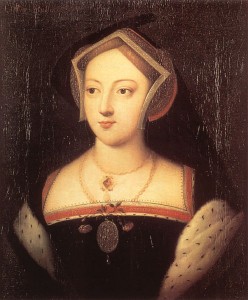
On Saturday 4th February 1520, Anne Boleyn’s sister Mary Boleyn got married to William Carey in the Chapel Royal at Greenwich Palace.
We know that the king attended and that he made an offering of “6s. 8d.” (6 shillings and 8 pence) at the service, because this is recorded in the 1520 King’s Book of Payments, but we don’t have any further details of the wedding.
The marriage was a good match for both the bride and groom. Mary was the the daughter of Thomas Boleyn, Henry VIII’s ambassador at the French court and a man on the rise, and his wife Elizabeth Howard, daughter of Thomas Howard, 2nd Duke of Norfolk. William Carey was a member of Henry VIII’s Privy Chamber and an Esquire of the Body, and he was descended from Edward III, and his maternal grandmother was cousin to Henry VIII’s paternal grandmother, Margaret Beaufort. Both families must have been pleased with the match.
The couple would have lodged at court after their wedding, allowing Carey to continue his duties serving the King. They both attended the Field of Cloth of Gold in June 1520, serving the King and his queen consort, Catherine of Aragon, there. The couple went on to have two children: Catherine in around 1524 and Henry in 1526. Although it is often said that Mary’s children were actually fathered by Henry VIII, there is no firm historical evidence for this. All we know for sure is that Henry VIII slept with Mary at some point. Henry VIII may well have slept with Mary before February 1520 and then arranged her marriage with his loyal servant William Carey after he had ‘finished’ with her, rather than sleeping with her as a married woman. We just don’t know.
William Carey died in June 1528 of sweating sickness and Mary married again in 1534, taking William Stafford as her second husband. Mary died on 19th July 1543. You can read more about Mary Boleyn in my article Mary Boleyn – One Big Boleyn Myth. Adrienne Dillard has written a book on Mary Boleyn’s daughter Catherine – Catherine Carey: In a Nutshell.
Notes and Sources
- The King’s Book of Payments 1520, LP iii p1539 (The King’s Book of Payments, 1520, in Letters and Papers, Foreign and Domestic, Henry VIII, Volume 3, 1519-1523, ed. J S Brewer (London, 1867), p 1539.